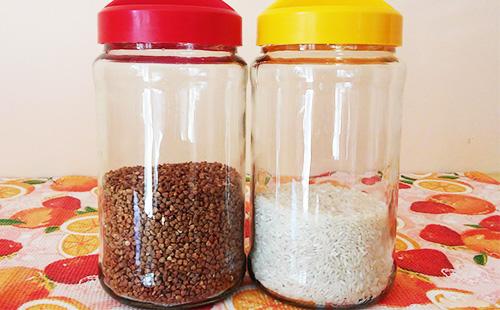The content of the article
These insects are not as harmless as it might seem at first glance. They do not just spoil the product - eating infected cereals is fraught with allergies, poisoning, upset stomach. How do these parasites get into our house and spoil stocks? As a rule, cereals purchased in stores become the source. It is especially risky to buy them by weight.
Insect species
There are four main types of bugs planted in cereals and flour:
- small hrushchaks;
- red flour eaters;
- bread grinders;
- food moth.
The main features of each species are displayed in the table.
Table - Insects that most often wind up in food
| Title | The size | Where dwells |
|---|---|---|
| Small Khrushchaks | 3-3.5 mm | - flour; - starch; - rice; - dried fruits; - semolina; - millet |
| Red flour eaters | 1.5-2 mm | - Wheat flour; - feed; - cereals |
| Bread grinders | 2-3.5 mm | - cereals; - cereal products; - tea (including medicinal); - coffee; - flour; - crackers; - feed; - cigarettes; - biscuit; - dried fruits |
| Food moth | 6-10 mm | - cereals; - nuts; - dried fruits; - tea; - sweets |
Small Khrushchaks
Relatively long dark red bugs. They can be recognized by short antennae and small wings, the presence of which, however, does not provide the ability to fly.
The source of infection with this parasite is packaging with starch or flour. Getting to the hostess in the kitchen, the Khrushchaks are spreading over the entire area of the room. They penetrate small cracks, loosely closed jars of bulk products. Most often they are “attracted” by wheat flour, rice, buckwheat, semolina andmillet cereals, dried fruits. Getting into the most favorable conditions for life, the Khrushchaks begin to multiply actively.
Red flour eaters
Usually found in large industries - bakeries and enterprises for the production of animal feed. These are small brown bugs. Their body is covered with short hairs.
Parasites are localized in products whose relative humidity exceeds 17%. Therefore, quite often their habitat is flour and cereals, in which the processes of decay began. Also, red-haired flour-eater can start in compound feeds. Getting in favorable conditions, it stimulates an increase in the moisture level of the product, clogs it with the results of its vital activity, larvae.
Bread grinders
The most harmful parasites, characterized by high appetite and high survivability. To get rid of these insects, you need to try very hard.
The shape of the grinder's body resembles a cylinder covered with small soft hairs. There are brown and red colors.Often in the house where these insects live, on the windowsills you can see them alive or dead.
Food moth
He prefers to dwell in loose mixtures, sometimes in tea, which are stored in unventilated jars. To destroy this dirty trick, it is necessary to carry out a full cleaning of the entire apartment and places of food storage.
Reasons for the appearance
The appearance of insects in cereals does not indicate the irresponsibility of the hostess. Even if you thoroughly wet the entire kitchen every day and wash the cabinets where the provisions are stored, no one will guarantee that parasites will not start there.
Most often, bugs get into cereals through the fault of the manufacturer. Possible reasons:
- neglect of the rules of sanitary safety at work;
- violation of product storage conditions;
- lack of necessary heat treatment of products.

Ways to scare animals
Save infected products will not work. Therefore, the main method of controlling parasites is prevention. To prevent the appearance of animals, follow three recommendations.
- Dry it. This rule applies to bulk products. Having brought from the store, dry them in the oven at a low temperature for half an hour.
- Freeze. In this case, we are talking about packaged cereals. Packaging can be put in the freezer for a day. Then pour the contents into a special container and send to the cabinet.
- Add boiling water. And wash it. So should be dried fruit. And then keep them best in the fridge.
There are also a number of popular tips on how to store cereals so that bugs do not start.
- Garlic. Place unpeeled garlic clove in the product jar. You can also lay heads on shelves in cabinets.
- Pepper. In particular, pods of hot pepper. Some housewives replace it with dried lemon peel.
- Salt. Two or three teaspoons of salt wrapped in gauze at the bottom of the container with the product will help protect the contents from the appearance of pests.
- Metal. Bugs are afraid of metal, so a spoon or foil at the bottom of the can will save dangerous guests.
Bulk storage periods
The most optimal solution is to purchase cereals, flour and pasta, counting so that they are enough for one to two weeks. If the habit of making stocks prevails, then consider the optimal shelf life of cereals (from the date of production):
- six months - semolina, rice, buckwheat, flour;
- four months — oatmeal, millet, kernel;
- 18 months - rice (polished - longer);
- from five to 18 months - pasta (depending on variety).
If you still wound up
First check all stocks, containers with cereals, dried fruits, flour. If insects are found in other banks, throw away everything, do not spare. Those cereals that have not been affected by parasites can be dried in the oven or frozen.
It is necessary to process the cabinet with a warm soapy solution, it is recommended to go through the solution again with the addition of a small amount of vinegar. Cabinets will have to be dried and very well ventilated.
Two more mixtures can be used for disinfection.
- With boric acid. Treat the shelves with a mixture of grated cereals, powdered sugar and boronic acid (take in equal proportions).
- With yeast. Treat the shelves with a mixture of sugar, borax and dry yeast (take in equal proportions).

The fate of damaged products
Thrifty housewives believe that it is possible to clean infected cereals with running water. But they do not take into account that vital products remain after insects. In addition, the larvae can be colorless, and you simply will not notice them before cooking. Such porridge with “meat” is hardly conducive to good appetite. And, most likely, will result in digestive problems. Also, do not give infected and expired food to pets.
A loose product affected by pests loses its taste and energy qualities. The insect eats the nutritious part of the grain, and what remains remains acquires a bitter taste and is already useless.

